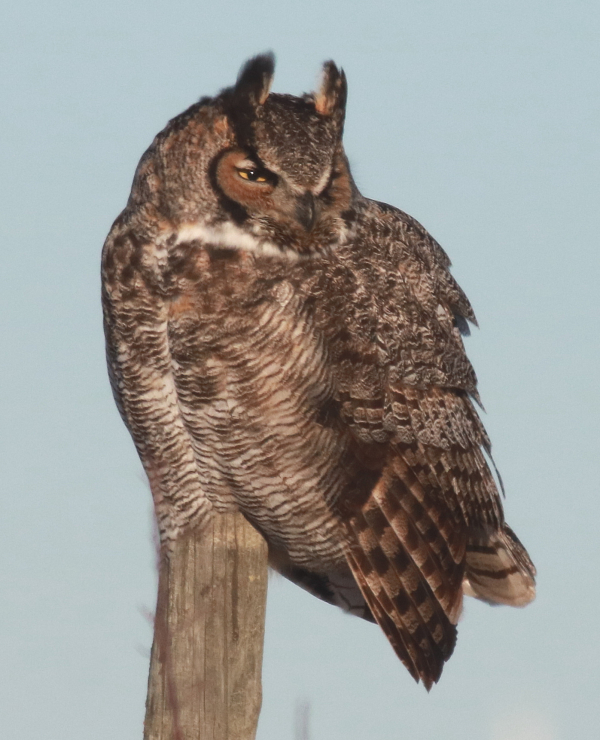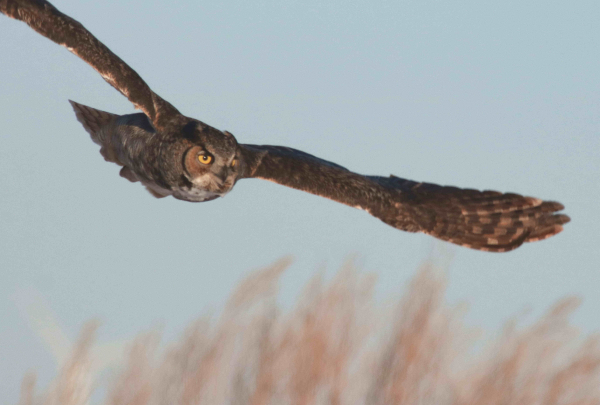
In the extreme cold, the Great Horned Owl perched with its plumage fluffed out to create a layer of body-warmed air space between its body and feathers; also note that it has covered its feet.

Focused on prey, this hunting flight added the opportunity to take a series of action photos.
...
|
After the coldest day and night of this winter, when temperatures at the northern tip of Alaska were warmer, Sunday it warmed to near zero, but I still had such low expectations for any kind of avian interactions that I finally forced myself out the door and up the road, northbound for an afternoon drive. I perked up after seeing a colorful Ring-necked Pheasant glowing in the frigid sunshine, followed by another one a mile down the trail. Then to see a huge flock of Common Redpolls that easily exceeded 100, probably closer to 120, I took a few minutes to watch them foraging on the ground and within the cover of cattails. Obviously, this polar drive had some inertia going.
I completed my northern circle and continued to drive south of my office, where only a mile away a big Great Horned Owl was perched, extra fluffed in the extreme clime. As I eased ever-closer, I took photos from a distance, and from a closer vantage, but stopped short of where I really wanted to be to give the owl some extra space. Even so, this was the closest I’ve been to a Great Horned Owl in a couple years – they seem overly prone to flight when I merely stop at considerable distances, so I appreciated the chance to take some pleasing portrait photographs.
From my position, it was quickly evident the grand owl was hunting – why else would it have been perched in the open an hour before advance of dusk? I watched and photographed, then was called to action as the owl suddenly raised its wings and hurtled from its perch to fly at an angle that crossed the trail in front of me. I took the first photo as soon as it twitched a wing feather, in advance of its leap as it raise its wings, and followed the winged action to document the owl’s eyes glued to what I expected must be potential prey. As it passed my position, I watched its gliding progress for 50 yards, but was surprised not to see prey, and the owl landed on the open ground on the edge of a cattail marsh.
Had the smaller animal slipped into cover as the owl silently advanced? Or did the owl simply reposition to be at a closer strike site? I decided to move on as the owl appeared to be waiting for the next move in a potentially deadly chess game. I found another flock of about 40 little redpolls about 11 miles south, and as I reversed my drive a couple minutes later, I was surprised that during the few moments that transpired after my first pass of the area a Great Horned Owl took a prominent perch adjacent to the location I sighted the redpolls, reminding me that the avian world is rarely static for long.
Inspired by Sunday’s surprising bird sightings, I cruised most of the same areas Monday afternoon, but didn’t see a bird until I was returning, when I was ½ mile to my office, 4 Horned Larks took flight next to the road, reminding me again that the avian world is rarely static for long.
Bismarck Raptors
I didn’t see any birds on the way to Bismarck last Wednesday, but within 7 miles of the big city I finally sighted a perched Rough-legged Hawk. A Bald Eagle 3 miles closer to town made me doubly excited as it perched in a big cottonwood tree, eating a Fox Squirrel. Two miles beyond the eagle I sighted another raptor in flight, then saw it begin to hover. Of course, Rough-leg would be the initial I.D., but a closer look after it perched revealed that this similar sized raptor was a Red-tailed Hawk. I can’t remember the last time I saw a Red-tail in the state during winter, but since I was along the Apple Creek treeline, not far from the woodlands of the Missouri River floodplain, it might be the most likely place to see one – even in February.
But this Red-tail was different; darker in color than the most Red-tails that visit the region, with a dark belly band. It was likely a bird from the Northwest, I thought; maybe originating in British Columbia or Alaska. I looked away a moment, and the hawk was gone – but not far as I caught sight of it fluttering down behind my position as though it was approaching prey on the ground. By the time I repositioned to face the raptor, it had perched on an adjacent post where I could see its brown tail – at least it looked brown through my 8x binoculars – indicating a first-year Red-tail.
The hawk was very active, moving from perch to perch, but continuing to patrol the area where it had apparently spied potential prey. As it flew this way and that, banking at times, I had nice opportunities to photograph it perched and flying. With such luck finding raptors east of Bismarck, I extended my birding south of the capitol along roads I frequented when I was in high school, when I was just starting to explore the region on my own. But not even a Wild Turkey showed itself in the wooded bottomlands along the Missouri – nice try.
Only after I returned home and anxiously reviewed the photos I took of the hawk was it apparent that this “dark northern” Red-tail was actually a light morph Harlan’s Red-tailed Hawk. That would, in effect, make it a bird from the Northwest, as Harlan’s summer range is primarily in Alaska and the Yukon, so I was on the right track. But it was the tail that threw me off initially; in the field, even with the aid of binoculars and my telephoto lens, it looked brown. But an extreme close-up of the digital photos on my computer screen showed the tail was a dappled gray with more of a brown and black terminal band. It all made sense at that point; that’s why the bird was so dark – almost black and white in body color.
Harlan’s are special hawks, and many raptor authorities believe they should still be considered a separate species – William Clark foremost, among others – and I agree, considering Bill’s excellent scientific case for returning Harlan’s to full species status. Most of the Harlan’s I see are dark morph Harlan’s, usually during spring or fall migrations; and I can really only point to light morphs I’ve seen wintering south of the other Dakota capitol – Pierre, South Dakota.
Friday Grouse Flight
During still sub-zero temperatures Friday, the bright sunshine drew me outside for an afternoon drive south along the hilly eastern edge of the Missouri Coteau, then a few miles east and down the escarpment onto the flatland of the Drift Plain. On the top of the escarpment, the first bird of the afternoon was evident on the edge of a planted belt of pine trees that were still weighted heavily by extra-thick frost. There, in something of a fairytale snowy setting, was a Great Horned Owl perched overlooking a hunting expanse.
On the Drift Plain below, about halfway back to my office I caught sight of a flight of 7 Sharp-tailed Grouse, probably headed for an ag field to feed. As I always say, during the depths of winter, you don’t see many birds, but the birds you do see are exciting.
Yard Excitement
“WoW, Wow, Wow,” I said outloud as I spied a colorful Common Redpoll on the ground at my feeding station Thursday. I’ve been waiting for redpolls to appear – certainly they have occasionally been in rural areas nearby in big flocks, but this was the first I’ve seen in my yard this winter – Hooray! But in a moment it was gone, and I’m still awaiting its return, or at least the return of a substitute(s).
Friday and Sunday a female Hairy Woodpecker stopped at my feeding station, the first female I’ve seen in weeks. Monday afternoon a rare female Downy Woodpecker visited too. The young Dark-eyed Junco continues to spend time on the ground near the feeders, but there have been no Pine Siskins since last Tuesday. It seems like there are at least 3 Red-breasted Nuthatches now that I’m seeing 2 females at a time occasionally, in addition to at least 1 male. Male Hairy Woodpeckers are periodic visitors some days, while White-breasted Nuthatches are regular, and Blue Jays less than regular. House Finches, with the males becoming ever-more colorful, number a dozen at times.
Looking ahead, the SoDak winter raptor hotspot is calling me, as is the Gulf Coast of Texas, and all points in Florida south to the Everglades. A week after getting my first covid vaccination, I’m 3 weeks away from my next, and I’ll be a free man again – or so it will seem when I hit the highway for an extended birding trip. I hope you have a great week with interesting birds a part of it. I’m proof that it only takes one bird to change everything – last week it was a trusting Great Horned Owl one day and a Harlan’s Red-tail another; but many other birds completed the birding segments of my life through the week, mostly the birds outside my windows.
Article and photos by Paul Konrad
Share your bird sightings and photos at editorstbw2@gmail.com